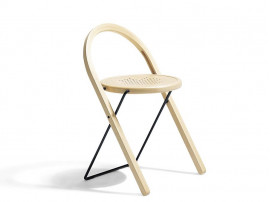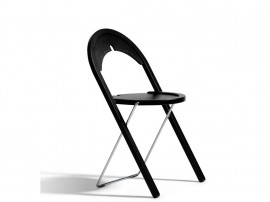
Börge Lindau
Börge Lindau (1932–1999) born in Åhus, qualified at what was then the Swedish Society of Arts and Crafts in Gothenburg and became one of the country’s most recognised designers. Börge formed Blå Station in 1986.
A strong character, dynamic, persistent, with a good sense of humour and demanding – of all involved – including himself. Loved and hated, sometimes by the same person. He was impossible to resist and got what he wanted. Most of the time.
Life for Börge was about doing things, To Do. It was often many different things at once such as designing furniture, glass and lamps to planning interior designs for libraries, churches and hotels. He started the Aoseum group for the protection of Åhus’ cultural life and invited Jazz artists and theatres to perform at Blå Station. In his own time he walked on the beach where he gained inspiration, cycled on his Pedersen bicycle into the village and involved people in his different schemes. He was always focused on the present but absent from day-to-day life while he pursued new ideas.
Börge Lindau was born into the trade - followed a family tradition if you like. His father a cabinetmaker and had a furniture shop in the small town of Ahus on the south-east-cost of Sweden. He was also the pastor of a Christian congregation. He had three sisters and was the only boy and also the youngest child, and yes, he was spoilt! Against his father’s wishes, Börge applied to study furniture and furnishings at the Higher College of Applied Art in Göteborg. It was here that he met fellow student Bo Lindekrantz, with whom he was ultimately to form a design partnership destined to last many decades. Having worked for other people for some time, the two later joined forces to open their own office in Helsingborg.
In 1965 Lammhults Mekaniska, which manufactured simple steel furniture, approached Lindau & Lindekrantz to review the company’s output. The two designers proposed a radical new range: thick steel tubes bent into expressive designs with lacquer and upholstery in bold new colours. While the 1930s heritage was clear, its manifestation was brand new. Lammhults decided to go ahead with the new range, which soon brought international acclaim for the company and unprecedented success for the two Swedish designers. Lindau & Lindekrantz furniture often drew inspiration from the past, but was famous for its innovative technology and supple design. L&L continued to work with Lammhults and other design companies for many, many years.
In the beginning of the 80’s the designers separated. Börge Lindau moved back to his hometown Åhus. During the 1980s Börge played a lot of golf – too much in fact – and finally came to the conclusion that he could make better use of his time. But the motivation for designing yet another chair was no longer really there. There were so many good chairs already. For a while he thought about opening a fish restaurant. His wife Karin had visions of herself standing gutting fish for the rest of her life, but Börge thought his idea was marvellous.
But then, in 1984, he was awarded the Forsnäs Prize together with Bo Lindekrantz for the best design for compression-moulded furniture. The prize was 30,000 Swedish kronor and a perforated veneer seat in a gold frame. ‘I suppose I ought to make a chair for this seat,’ Börge said in his brief acceptance speech. The motivation was there again and slowly the old machinery began to grind back into action once more.
In the end, it wasn’t just one chair – and it wasn’t just chairs, it became a family of furniture, OBLADO, and the family business Blå Station was founded in1986.
In the beginning the basic idea was a single, simple design concept; rings of compression moulded birch veneer would provide the basis for a rich and varied collection of stools, chairs and tables. As a furniture producer, the designer Börge Lindau suddenly found that he had the freedom to choose for himself – and almost immediately he established the most stringent of Criteria for what became the OBLADO range.
The components were all produced in the most environmentally friendly way possible and the cornerstones were light Finnish birch, stainless steel and vegetable-tanned leather.
As an architect, Lindau’s working methods were more akin to those of a stage designer or, rather, a choreographer, since his furniture always features an element of movement – movement derived from the manufacturing process’s bending and stretching or from the tension of the material. Movement which is consciously brought to the fore. Movement which attracts attention and captures the imagination in much the same way as if something had just happened in the room. A room inhabited not by people, but by sculptural forms, each set against yet working with the other. The concept of the room was extremely important to Börge. He was always aware of its limitations and possibilities – he saw it as part of his job. His relationship with his god echoed his approach to his work. Indeed, he once said: ‘The room is god. It is only in the shaping of a room that we can recreate the concept of god. A holy room is not an image of god, but it’s close!’
Börge was a man of considerable presence who had a strong sense of the theatrical and an awareness of the importance of entrances and exits. His work on the periphery of other professions was perhaps the real reason why he found it so easy to work with people from a variety of spheres. He had a great deal of respect for skills and knowledge, he listened carefully and drew inspiration from anything that he could use in his own work.
The town of Åhus became the setting for Börge’s wide-ranging cultural interests. He used his vitality and drive to bring jazz festivals and exhibitions to the town. Just before he passed on he realized AOSEUM cultural center, which came to be his final project.
Börge was forever active, a real doer, and he lived by the device that an idea is never better than it’s result. To Be and To Do. ToBeDo!


